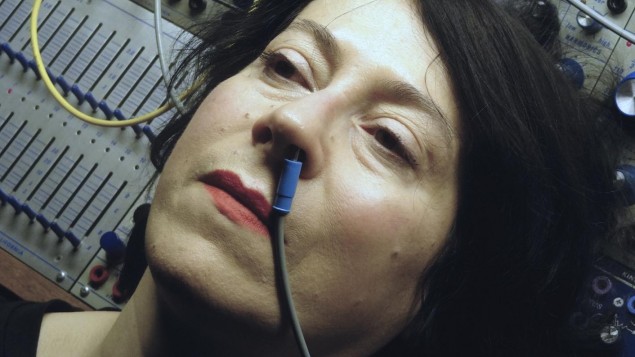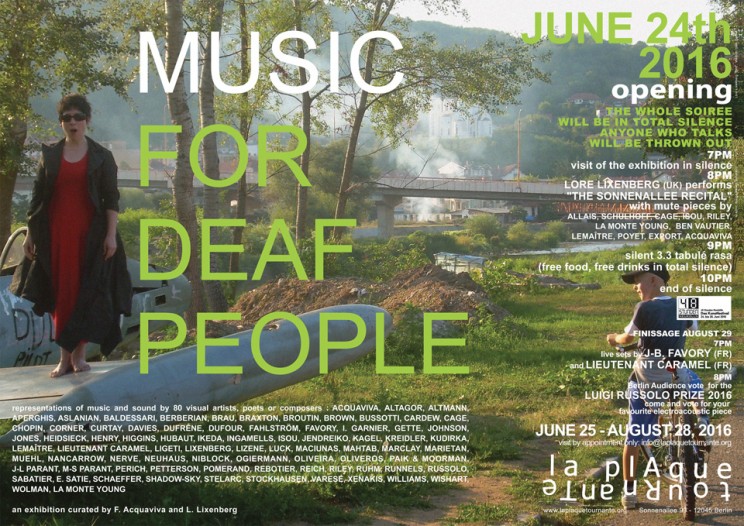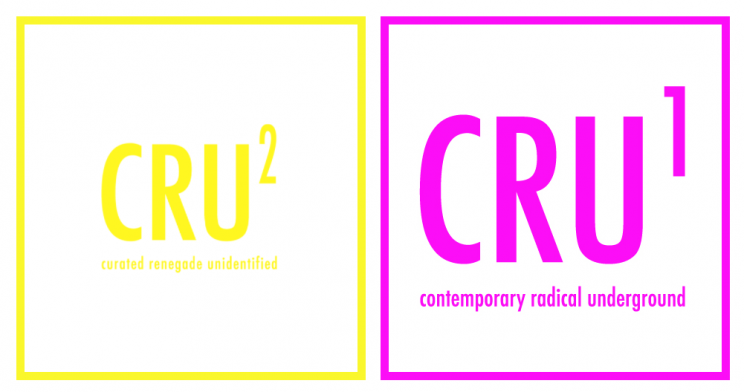Loré Lixenberg is a British-born singer and voice artist. She has a wide repertoire, and performs regularly alongside orchestras such as The Halle, Tokyo Phill, BBCSO and many others. One performance of note includes the lead role, as Dora Maar, in David Toop’s opera Star-Shaped Biscuit, which was performed at Aldeburgh in 2012.
In the 1990s, Lixenberg was closely involved with Cluub Zarathustra, an avant-garde comedy troupe that boasted Stewart Lee, Simon Munnery and Richard Thomas among its ranks. Together with Thomas, Lixenberg developed and starred in Jerry Springer: The Opera, a controversial and satirical musical based on the well-known television chat show. Now based in Berlin, Lixenberg runs La Plaque Tournante – a cross-disciplinary art space focusing on inquiry and experimentation – along with composer and frequent collaborator, Frédéric Acquaviva. CRU, an annual magazine published by Lixenberg and Acquaviva, documents “what’s happening or what could have happened at La Plaque Tournante”.
On the 17th January 2017, Lixenberg performed alongside Frederic Acquaviva in his new work, MESS. The piece was composed for voice, skins, mouth, and the Buchla synthesiser. MESS was broadcast live via Deutschlandradio Kultur. This interview took place, at IKLECTIK, a few days after the performance.
Ilia Rogatchevski: I want to ask about your background. It is extremely varied and incorporates opera, comedy, direction, curation and publishing. How did you arrive to where you are now?
Loré Lixenberg: Everything I do, including activities that aren’t obviously vocal, are extensions of my vocal technique and came out of an inquiry about voice. I learned classical singing, because I wanted to have a technique that could help me do lots of different kinds of music and explore things a bit deeper. Natural voices, I think, are fantastic, but I wanted to go further.
Is that something that you discovered on your own – the need to develop your voice in different directions?
I went to some really great teachers, but I chose my own path. I didn’t go to music college. I heard people whose voices I really liked and went to them. For instance, Galina Vishnevskaya, who is a great Russian soprano, or Elisabeth Söderström, who is a great Swedish soprano, and a wonderful teachers David Mason and Nick Powell.
The thing about Bel Canto technique is that people think it’s the voice of the elite. It has very strong associations, not all of which are positive, but I see it as a folk style that has been extended into a vocal technique. It’s from Italy and if you go to there and hear these folk [vocal] styles, you really hear the Bel Canto technique within them.
Although I started my music education as a composer studying with John Woolrich, Andy Vores and Robert Saxton. I went to the City University music department that at the time called itself The Consciousness Transformation Department!
I’d like to pick up on your work in comedy. You played an important role in Jerry Springer: The Opera, which is an immediate point of reference for many people. I’m interested to find out how you found that experience. Have you worked in comedy since? Do you think that laughter is conducive to your practice?
I’m passionate about comedy. Nobody takes it seriously enough. It’s all about timing and psychology. Perhaps it’s a bit serious to think about it that way, but I’ve had experiences with Richard Thomas where we would do a tour and we’d literally turn a room. The temperature in the room would turn for or against you. It’s literally a nanosecond between a joke landing and not.
The comedy I was involved in had a lot in common with music, free improvisation and performance art, especially from the 60s. When I was working in Cluub Zarathustra, in the 1990s, Simon Munnery was really involved in all of this. And I see a lot of composers now, taking on all of these things those comedians were doing (as well as from Nam June Paik, John Cage, Mauricio Kagel). For example, playing with technology or mixing up different styles [of delivery and performance].
Isn’t that how the idea for the Jerry Springer developed, because you’d be singing insults at hecklers?
Yes, it sort of came from that. Basically, I would be the opera device. If Richard or Simon or any of them were heckled, I would come out and sing expletives at the top of my voice at those people. Another job would be to warm the audience up as they came in. They would be sitting there and I would give them instructions from this throne that Simon had built. Jerry Springer also came out of the idea of using the innate operatic quality of heightened human situations that are presented in all their dubious glory on the Jerry Springer show.
But before Jerry Springer, I did a piece called Tourette’s Diva (2000), which was about a dysfunctional relationship between a mother and her daughter. It was basically one gag after another, but it was very dark. Really on the edge and much more so, in some ways, than Jerry Springer. It’s quite funny that there was so much fuss, with the far-right Christians going crazy [about Jerry Springer], but some of material in Tourette’s Diva was really fucked up.
Let’s move on to what you’re doing currently. In the description of the piece, MESS,which was performed in collaboration with Frédéric Acquaviva, you’re described as a “post-Brexit mezzo” – a voice without borders. To what extent would you agree with that description and what relationship, if any, does your voice have to border crossing, migration and liminality?
Frederic wrote this piece for me. He wrote it for Buchla, skins and mezzo. Sometimes I use mezzo to describe myself, sometimes I don’t. It’s a fantastic piece. Sometimes you can’t really tell what’s the Buchla and what’s the voice, because of the way he has written it. It’s very exact.
This idea of crossing borders describes me very well: always being in the cracks, somehow. Although that’s not a good analogy for voice, is it? [Laughs]. But also because I love to play with all these different colours, styles and techniques. I learnt Sevdah songs for a while, Bulgarian and Georgian music. I also studied carnatic techniques and other vocal disciplines for a while – I wouldn’t say I was an expert by any means – but I really went into these vocal techniques as much as a Westerner can.
And you’re an itinerant artist. You’re now in Berlin, but you were based in Vienna before that. How does the farcical reality of Brexit impact on your work?
I await with dread, I really do. The avant-garde, the experimental is international. I think it is very difficult to find an avant-garde that stays put. The whole journey of it has been to expand itself. So far, I don’t know about the practicalities – I just have to wait – but in terms of attitudes, that’s what I find the most scary. You don’t know what people think now, whereas before you thought that everyone was sort of on the same page and travelling towards a new ‘enlightenment’.
I’m also optimistic. Since the beginning of time, creativity and artists – like water and weeds – have always found the cracks in which to exist and flourish. The important thing is to keep going, to keep working, to be there, as an alternative, and to be there when the tide one day turns again, which it inevitably will.
That’s why Berlin is such a good place to be, because it’s still very open there. I think in London, there is a strata of people, especially musicians and artists, who are very open, but you just don’t know. [Brexit] has definitely awakened something ugly and repressive in some people.
Something you didn’t really know was there.
Or maybe it wasn’t there until it got an opportunity to be expressed.
Let’s talk a little bit more about Berlin. You’ve got a space there called La Plaque Tournante. What are its aims and origins?
It really came about from both Frederic and I wanting to start a space that was devoted entirely to the experimental and avant-garde. A true avant-garde. There are a lot of things going on that call themselves experimental or avant-garde, but they don’t have that rigorous spirit of inquiry.
We wanted a space that was modular and where visual and sonic art had equal weight. It’s not a gallery or concert space. It’s much more fluid. It’s in this old doctor’s surgery. There’s lots of different rooms connected by corridors, so every time you walk in there it’s different. Each event has a different vibe to it and each room can be used differently. For instance, one room can be used as a cinema and then it suddenly turns into a room with a bio-top in it. It changes shape, shrinks and expands.
CRU magazine documents “what’s happening or what could have happened at La Plaque Tournante”. I’m interested about the impetus behind publishing the magazine annually, rather than quarterly, or publishing documentation online, as it happens, or in booklets. What were the reasons behind this decision and choosing the 12” record sleeve format? What has been the response to these publications?
CRU magazine has a physical and an online presence. When you open the physical CRU magazine, there are posters and postcards you can pull out. Each poster is like a mini-exhibition. You can put all the posters on a wall and you’ll have the exhibition series from the whole year on your wall. And then, in the deluxe version, there are signatures of all the artists and two unique editions by artists [who participated in our programme] through the year. If the magazine was published quarterly, you’d only have one exhibition. I think it’s more interesting to have an overview of the whole year.
And the vinyl, well it’s playing with the of presentation, because everyone loves vinyl. It has really come back, it’s fashionable all of a sudden. CDs are not so fashionable. It’s just one of those things. The really great thing about vinyl is the surface area on which to put an image. The format comes from a sense of irony and critical sense. People at book fairs would come up to us and go: “Ooh, it’s a vinyl! But it’s not a vinyl! What is it?” We wanted to create a hybrid.
You open it up and there are CDs inside…
Yes, exactly. There is also an online presence,when you buy CRU you can send a selfie to us. In return you get a code that gives you access to the online version of the magazine. The online magazine has many more photos as well as webcam footage from cameras placed in all the rooms during the events.
As an object, it appeals to people. Frederic’s work – he’s got an exhibition on at the moment at La Plaque Tournante called Music & Multiples, Multiple Musics – and some of his work is about that. The physical presence of the score or the recording is as important as what you hear. For instance, he composed a piece called Le Disque, which also plays with this vinyl format. It’s a vinyl shape, but it has CDs stuck to it and you take the CDs off… So, there’s a lot of play to this formatting.
And does that have a relationship to the name of the space?
You would have thought so, but [la plaque tournante] actually comes from the French term for a railway turntable. It’s also a euphemism for places where dodgy deals happen.
Dodgy deals of the avant-garde…
Yeah, exactly. It’s got lots of meanings.
One of the events that roused my interest was Music for Deaf People. It was a concert of mute works by composers like John Cage, Terry Riley, Isidore Isou and others, which are all performed in total silence. I’m interested to find out how that worked. No one was allowed to speak and, if you did, you were thrown out. What did you learn from that experience? Was it zen or was it the opposite?
It was fantastic! Personally, I absolutely loved it. Normally at the vernissage of something everyone’s chatting and drinking. It’s very loud and people are discussing [the work]. This time there was total silence. I think there was more concentration on the work, because people couldn’t speak they were more focused on their own private response. They had to go outside to speak.
As for the recital itself, well, the pieces were just fantastic. All together they are really powerful and it’s great experience them bam, bam, bam. One after the other. You realise how silence is different every time. There is no such thing as one kind of silence. Every piece sculpted the silence in a different way. Sometimes its a really solid silence sometimes lighter and more fizzing. And from the audience, there was a really intense quality and concentration of listening.
It’s interesting that you say that, because even though they’re all different pieces, they’re performed in the same context. I would have loved to have been there.
Hopefully, we’ll do it again. The Silent Recital really, really works. It creates a space all of its own. Conversely, I also do something called Pret a Chanter there. It’s a cafe, which is an art piece. It is a real-time opera that has a manifesto and everyone has to vocalise in any way other than speaking. For instance, the conversation we’re having now, we’d have to be singing or grunting it. You can use any language or any sounds, but anyone who speaks gets thrown out.
Would you say that performances like this are more critical, more radical, more underground in Berlin than in London? Presumably, there is a reason why spaces like yours thrive in places like Berlin.
That’s simple. It’s money. For the space we’ve got, in the kind of area that we’re in – which is Rathaus Neukölln, similar to what Dalston was like ten or fifteen years ago – you couldn’t afford it. London does have a great scene though. There are things that happen in London that don’t exist in Berlin. With B@£ and £@B we want to make a link between activities in these two great cities.
Would you say that these economic conditions attract radicalism?
I think it just makes it more possible. There’s something about the word ‘radical’… I would put the focus on the experimentation, creativity and originality.The most important thing is experimentation and inquiry with a rigorousness to it as well. So that you’re not just randomly flapping around, but there is a real super-focus to what goes on, with a community of people who can simply afford to be there.
CRU magazine is available to purchase from the IKLECTIK book shop. La Plaque Tournante website.






